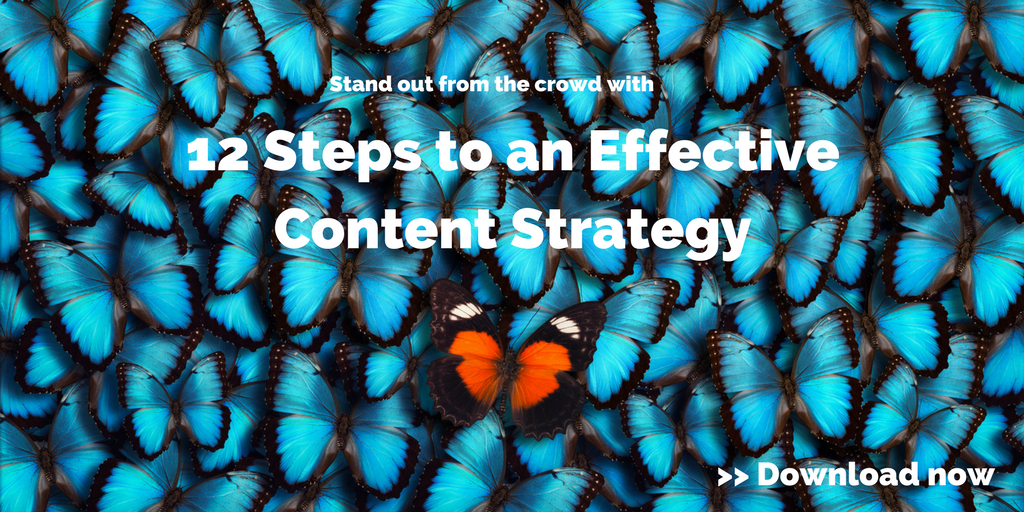
by Fronetics | May 9, 2019 | Blog, Content Marketing, Logistics, Manufacturing & Distribution, Marketing, Supply Chain
Putting your audience’s informational needs first when publishing blog content is the only way to guarantee success in the modern marketing landscape.
Highlights:
- Audiences are increasingly ignoring promotional messaging.
- Buyers are seeking value from vendors outside the sales funnel.
- Information is your best asset — publish what you know.
The latest industry research from the Content Marketing Institute indicates that nearly all (90%) of the most successful B2B content marketers have one thing in common: they prioritize their audience’s informational needs over their sales/promotional message. And that’s compared with only 56% of the least successful B2B content marketers.
Materials-handling marketers should take note when making decisions about publishing blog content. We see companies in this sector making this mistake all the time. They want to fill their blogs with information about their products. But to achieve success in today’s B2B purchasing landscape, you need to be prioritizing your audience’s needs over promotional messaging.
Sales pitches get ignored
A large reason for shifting focus is because audiences are increasingly tuning out sales pitches. This generation of buyers has been heavily marketed to their entire lives, and they don’t hesitate to swipe left at the slightest hint of someone trying to sell them something.
Think for a moment about your own personal experiences with email, social media, and even phone calls. The truth is, most of us tune out overt sales pitches, either hitting delete or scrolling past them. We’ve moved beyond a time when marketing is about pushing your products.
Your blog, therefore, should not be another channel for selling. But, what kinds of information should you publish?
Provide value by putting customer needs first
The answer is actually quite simple. What information or expertise do your buyers want? Your most valuable commodity is your unique understanding of the challenges your audience faces. If you begin publishing blog content that answers their questions, they’ll be more likely to find you, remember you, and become your customer.
As you think about publishing blog content, take a step back and think about the questions your buyers ask, either of you, on social media, or elsewhere. Examine industry publications to determine the challenges faced by your target buyer persona.
Does your content answer those questions? Does it offer value in and of itself? And does it inform your audience about how you are there to help them? If the answer to these questions is yes, then you’re taking the right steps toward materials-handling marketing with today’s B2B buyers.
Related posts:


by Fronetics | Apr 24, 2019 | Blog, Content Marketing, Marketing, Marketing Automation
Artificial intelligence is reshaping the way we live and do business. But can robots replace humans when it comes to content creation?
Highlights
- Artificial intelligence is already creating content.
- Some analysts predict that human writers will become obsolete in time.
- At least for now, there are aspects of human-generated content that robots can’t replicate.
What used to be a light-hearted, science-fiction version of the future — in which menial jobs would increasingly be performed by robots — has increasingly become a reality. We’ve seen how automation has shaped the supply chain and logistics industries in the past decade. But as artificial intelligence (AI) continues to evolve and reach new levels of sophistication, will something as complex as content creation no longer require human input?
AI is already creating content
In 2016, McKinsey Quarterly predicted that “while automation will eliminate very few occupations entirely in the next decade, it will affect portions of almost all jobs to a greater or lesser degree, depending on the type of work they entail.” Of course, there are jobs that require empathic functions or advanced social skills, which are less subject to replacement by machine learning. But content creation, though it does require original thought and synthesis of complex ideas, is in a greyer area.
The fact is, AI-generated content is already a reality. It shouldn’t come entirely as a surprise. After all, we’ve been writing about marketing automation for a while now, including, for example, chatbots or computer programs that simulate human conversation. According to Joe Pulizzi, founder of the Content Marketing Institute, “In 10 years, the majority of content will be generated by software. In 20 years, humans will wonder why we wasted so much time on content creation.”
In a notable example of AI creating content, the Washington Post developed “Heliograf,” a bot capable of generating short reports for readers, to aid in the coverage of the 2016 Olympic Games in Rio. When it was first developed, Heliograf could update readers on game outcomes, including when medals were awarded. Since then, it has written over 850 articles, including updates on high school football games and automated earnings coverage. Even now, the Washington Post uses Heliograf to supplement the work of its human writers — and has no intention of replacing them.
Natural language generation
Before we get further into the nitty-gritty of whether human content writers are doomed to obsolescence, let’s take a step back and take a look at the main function of AI when it comes to content creation. Natural language generation (NLG) is how we describe AI that can produce logical, coherent text.
“Natural language generation is a software process that automatically turns data into human-friendly prose,” writes Laura Pressman of Automated Insights. It’s important to recognize that while NLG can create content, it can’t do so without being fed data and a templated format. Essentially, when given data and a format, NLG can output content that reads as if it was written by a human.
Why we still need humans
It’s staggering what AI can produce when it comes to convincing, effective content. But even as technology becomes smarter and more sophisticated at creating content, humans haven’t been replaced just yet.
Proponents of fully AI-driven marketing argue that the kind of creativity required to produce effective content marketing can all be boiled down to numbers. While it’s true that content marketing should be data-driven, studies are also increasingly showing the value of intangible creativity — the kind that can’t be generated by an algorithm — in the marketing sector and beyond.
The memories, emotions, preferences, and frailties of human writers allow for the possibility of creativity and connection that AI can’t replicate. Yes, content marketing is about data. But there’s no substitute for the way a human brain can create language and ideas that connect and resonate with another human brain.
Related posts:


by Fronetics | Apr 23, 2019 | Blog, Content Marketing, Marketing
As the purchasing landscape increasingly skews younger, you need to think about how to improve your visual content to satisfy buyers’ preferences.
Highlights:
- Audiences increasingly prefer visual content.
- Optimize visual content for search engines by including text.
- Use graphics to make data pop.
Digital natives, who make up the majority of today’s B2B purchasing landscape, are highly steeped in online content. And, it may come as no surprise, they overwhelmingly prefer visual presentation, whether in video, infographic, animation, or gif format. What does this mean? Supply chain marketers need to adapt or be left behind.
While this doesn’t mean that text-based marketing is a thing of the past, it does mean that all your branded content — from blog posts to infographics to case studies to video — needs to be design-minded and visually appealing. These five suggestions will help improve your visual content game.
5 ways to improve your visual content
1) Optimize for search engines.
The biggest downside to visual content such as videos and infographics is that they aren’t searchable in the way that text-based content is. But this doesn’t mean that you need to lose out on the SEO benefits when publishing this type of content.
First off, it pays to post a text transcript with video or accompanying explanatory text with infographics and images. It’s also important for you to categorize and organize your visual content, which means labeling visual assets like logos and images with relevant keywords. When publishing them, be sure to tag images with keywords.
2) Make data interesting.
Common sense tells us that reading a bunch of numbers is far less compelling than seeing numerical data presented graphically. B2B marketers are in a prime position to make use of attractive data presentation, such as charts, graphs, animated images, or other formats to display your numerical data.
3) Create reusable graphics.
If you’re investing in visual content creation, it pays to consider how it can be reused. For example, when creating an infographic, consider how you can break it up into multiple graphics, each containing a set of statistics or other information. This way, you can add these smaller graphics to other pieces of text content, boosting engagement and adding visual appeal.
Additionally, keep in mind that visual snippets are ideal for posting on social media, as teasers, or even self-contained Instagram or Facebook Stories.
4) Keep your branding consistent.
A key point with visual content creation is consistent branding. Your brand’s visual presentation includes fonts, colors, font sizes, image styles, and anything else that is a visual indicator of your identity.
The first step to consistent branding is to document visual guidelines clearly and to distribute them to all content creators, along with samples for their use. Each time you publish visual content, make checking against the guidelines part of your editorial process.
5) Use visual content to tell a story.
Good content marketing is all about presenting information in a story format. Great content marketing also packs emotional resonance. When creating visual content, start with the idea of telling a story. Ideally, you’re presenting data in a way that communicates a feeling and elicits an emotional response from the viewer. If your data is impactful, your viewers will forge an emotional connection with your brand.
How are you trying to improve your visual content?
Related posts:


by Fronetics | Apr 4, 2019 | Blog, Content Marketing, Marketing
The best way to come up with creative and engaging content is to think outside the box and sometimes, take risks. Here are 4 rules to break to produce truly creative content.
Highlights:
- Throw out the template approach to content and start thinking about what makes you stand out.
- Don’t be afraid to showcase what you do best through different avenues, like customer or vendor testimonials.
- When you’re committed to curiosity, you naturally become a learning organization and this learning leads to more creative content.
Video transcript:
I’m Elizabeth Hines, and I’m the Creative Director at Fronetics, and today we’re talking about for more creative content, you have to break these four rules.
With over 4 million blog posts published every day, you have to be really creative with your content in order to drive traffic and win over prospects and leads.
So in order to do so, you’re going to have to break these four rules.
1. Mirror competitors
If you’re in this certain industry, then you have to cover these certain topics. You might think because your competitors are covering this certain topic or that certain topic, you should be covering it as well. Not so. You should be covering the topics that are unique to your business, that your company offers expertise in and the ways you stand out from your competitors.
2. Marketing mindset
While your marketing team has a great idea of what is going on in your, some of the best stories and the best blog content comes from your other teams. Maybe your sales team, sometimes your customers or your vendors have a really good prospective or a really good story to tell. And some of the most creative content comes from those unique prospectives.
3. Keep it obvious
It can be really tempting to do a quick brainstorm, come up with a couple good ideas, things that are obvious and things that stand out about your company. But you’re going to get much more creative content if you dig a little deeper. For example, if your first instinct is to talk about self-driving vehicles, a very popular topic right now, can you offer a new perspective on that topic? Can you talk specifically about the sensors that are involved in that technology? Can you talk about government regulations of that technology? What new perspective can you offer to that often talked about conversation?
4. Repeat success
Now this is a little bit controversial because I do encourage you to look at what’s been successful in the past and try to build on that and try to repeat that. But you should also be taking some risks when you’re developing your content calendar. Build in a healthy mix of what’s worked for you in the past, what resonates with your target audience. Then something new, something different, something totally out of left field, because you need to keep experimenting. You need to keep trying new things because your audience is going to evolve and your content should evolve creatively as well.
For more information, visit our website at fronetics.com.
Related posts:


by Fronetics | Mar 26, 2019 | Blog, Content Marketing, Logistics, Marketing, Supply Chain, Video Marketing
The popularity of video marketing is on the rise, and savvy supply chain marketers are using this medium to tell their brand’s story, broaden their audience, and generate leads.
Highlights:
- Use video to tell your brand’s story, broaden your audience, and generate leads.
- As marketing expands in a more visual direction, marketers should adjust their strategies to favor content that lends itself to this kind of storytelling.
- Consider accompanying data-heavy blog posts with explanatory animated videos, conducting and sharing video interviews with industry executives, or turning a case-study into an animated video presentation.
Video transcript:
I’m Frank Cavallaro, CEO and founder of Fronetics, and today I’m going to be talking about video marketing and the supply chain.
Video is the most popular content being consumed online today. And it shows no sign of letting up. Video let’s savvy marketers tell their brand’s story, broaden their audience, and generate more leads. Video allows the marketer to consistently deliver content that is visually stimulating and valuable.
[bctt tweet=”Using animated video for case studies makes them easier to understand for the user. And because they’re entertaining and engaging, there’s a huge ROI that comes along with them.” username=”Fronetics”]
Consider pairing data-heavy blog posts with some sort of video, whether its animated or a subject matter interview. Using animated video for case studies makes them easier to understand for the user. And because they’re entertaining and engaging, there’s a huge ROI that comes along with them.
When using video remember what you need is quality, high engaging, well researched content. For more information, visit us at fronetics.com.
Related posts:









